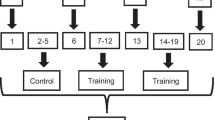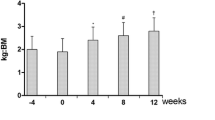Abstract
Purpose
The present study tested the hypothesis that resistance exercise training focusing on eccentric muscle contractions would improve muscle strength and functional physical fitness more than concentric contraction-focused resistance training in older adults.
Methods
Healthy older adults (65–84 years) were placed into eccentric (ECC; n = 9) or concentric training group (CON; n = 8). They performed 4–6 basic manual resistance exercises focusing on either eccentric or concentric muscle contractions once at a community centre and at least twice at home a week for 8 weeks. Muscle thickness of the quadriceps femoris (MT), knee extensor maximal voluntary isometric contraction strength (MVC), 30-second chair stand (CS), 3-metre timed up and go (TUG), 2-minute step (2MS), sit and reach (SR), and static balance with eyes open and closed (Bal-EC) were assessed before and 7 days after the last community centre session.
Results
Changes in MT (ECC: 21.6 ± 9.2% vs CON: 6.7 ± 7.1%), MVC (38.3 ± 22.6% vs 8.2 ± 8.4%), CS (51.0 ± 21.7% vs 34.6 ± 28.3%), TUG (16.7 ± 9.9% vs 6.3 ± 7.7%), 2MS (9.9 ± 6.0% vs 6.0 ± 7.3%) and Bal-EC (35.1 ± 6.7% vs 8.8 ± 16.2%) from baseline were greater (P < 0.05) for the ECC than the CON group.
Conclusion
These results show that the eccentric manual resistance exercise training was more effective for improving lower limb strength, mobility, and postural stability of older adults when compared with the concentric training. This suggests the significance of emphasising eccentric muscle contractions in movements to maintain and improve physical function.


Similar content being viewed by others
Abbreviations
- ADL:
-
Activities of daily living
- BM:
-
Body mass
- BMI:
-
Body mass index
- CV:
-
Coefficient of variation
- CON group:
-
Concentric resistance exercise training group
- DBP:
-
Diastolic blood pressure
- ECC group:
-
Eccentric resistance exercise training group
- HR:
-
Heart rate
- MVC:
-
Maximal voluntary isometric contraction
- QOL:
-
Quality of life
- RPE:
-
Rating of perceived exertion
- SBP:
-
Systolic blood pressure
- TMT:
-
Trail making test
References
Barbosa AR, Santarém JM, Filho WJ, Marucci Mde F (2002) Effects of resistance training on the sit-and-reach test in elderly women. J Strength Cond Res 16(1):14–18
Bemben MG (2002) Use of diagnostic ultrasound for assessing muscle size. J Strength Cond Res 16(1):103–108
Borg G (1970) Perceived exertion as an indicator of somatic stress. Scand J Rehabil Med 2(2):92–98
Bouchard DR, Héroux M, Janssen I (2011) Association between muscle mass, leg strength, and fat mass with physical function in older adults: influence of age and sex. J Aging Health 23(2):313–328
Chen TC, Hsieh CC, Tseng KW, Ho CC, Nosaka K (2017a) Effects of descending stair walking on health and fitness of elderly obese women. Med Sci Sports Exerc 49(8):1614–1622
Chen TC, Tseng WC, Huang GL, Chen HL, Tseng KW, Nosaka K (2017b) Superior effects of eccentric to concentric knee extensor resistance training on physical fitness, insulin sensitivity and lipid profiles of elderly men. Front Physiol 8:209
Cohen J (1988) Statistical power analysis for the behavioral sciences, 2nd edn. Lawrence Erlbaum Associates, Hillsdale, p 567
Ema R, Ohki S, Takayama H, Kobayashi Y, Akagi R (2017) Effect of calf-raise training on rapid force production and balance ability in elderly men. J Appl Physiol 123(2):424–433
Fukusaki C, Masani K, Miyasaka M, Nakazawa K (2016) Acute positive effects of exercise on center-of-pressure fluctuations during quiet standing in middle-aged and elderly women. J Strength Cond Res 30(1):208–216
Gremeaux V, Duclay J, Deley G, Philipp JL, Laroche D, Pousson M, Casillas JM (2010) Does eccentric endurance training improve walking capacity in patients with coronary artery disease? A randomized controlled pilot study. Clin Rehabil 24(7):590–599
He W, Goodkind D, Kowal P (2016) An aging world: 2015. International population reports. U.S. Census Bureau. https://www.census.gov//content/dam/Census/library/publications/2016/demo/p95-16-1.pdf. Accessed 08 Feb 2019
Hiyamizu M, Morioka S, Shomoto K, Shimada T (2011) Effects of dual task balance training on dual task performance in elderly people: a randomized controlled trial. Clin Rehabil 26(1):58–67
Kanda K, Yoda T, Suzuki H, Okabe Y, Mori Y, Yamasaki K, Kitano H, Kanda A, Hirao T (2018) Effects of low-intensity bodyweight training with slow movement on motor function in frail elderly patients: a prospective observational study. Environ Health Prev Med 23(1):4
Katsura Y, Ueda S, Yoshikawa T, Usui T, Orita K, Sakamoto H, Sotobayashi D, Fujimoto S (2011) Effects of aquatic exercise training using new water-resistance equipment on trunk muscles, abdominal circumference, and activities of daily living in elderly women. Int J Sport Health Sci 9:113–121
LaStayo PC, Ewy GA, Pierotti DD, Johns RK, Lindstedt S (2003) The positive effects of negative work: increased muscle strength and decreased fall risk in a frail elderly population. J Gerontol Ser A Biol Sci Med Sci 58(5):M419–M424
Ledin T, Fransson PA, Magnusson M (2004) Effects of postural disturbances with fatigued triceps surae muscles or with 20% additional body weight. Gait Posture 19(2):184–193
Leong CH, McDermott WJ, Elmer SJ, Martin JC (2014) Chronic eccentric cycling improves quadriceps muscle structure and maximum cycling power. Int J Sports Med 35(7):559–565
Park SH (2018) Tools for assessing fall risk in the elderly: a systematic review and meta-analysis. Aging Clin Exp Res 30(1):1–16
Rabin LA, Barr WB, Burton LA (2005) Assessment practices of clinical neuropsychologists in the United States and Canada: a survey of INS, NAN, and APA Division 40 members. Arch Clin Neuropsychol 20(1):33–65
Rikli RE, Jones CJ (1999) Functional fitness normative scores for community-residing older adults, ages 60–94. J Ageing Phys Act 7:162–181
Stadnyk AMJ, Rehrer NJ, Handcock PJ, Meredith-Jones KA, Cotter JD (2017) No clear benefit of muscle heating on hypertrophy and strength with resistance training. Temperature (Austin) 5(2):175–183
Suetta C, Andersen JL, Dalgas U, Berget J, Koskinen S, Aagaard P, Magnusson SP, Kjaer M (2008) Resistance training induces qualitative changes in muscle morphology, muscle architecture, and muscle function in elderly postoperative patients. J Appl Physiol 105(1):180–186
Tanne D, Freimark D, Poreh A, Merzeliak O, Bruck B, Schwammenthal Y, Schwammenthal E, Motro M, Adler Y (2005) Cognitive functions in severe congestive heart failure before and after an exercise training program. Int J Cardiol 103(2):145–149
Theodorou AA, Panayiotou G, Paschalis V, Nikolaidis MG, Kyparos A, Mademli L, Grivas GV, Vrabas IS (2013) Stair descending exercise increases muscle strength in elderly males with chronic heart failure. BMC Res Notes 6:87
Topinková E (2008) Aging, disability and frailty. Ann Nutr Metab 52(Suppl 1):6–11
Underbjerg L, Sikjaer T, Rejnmark L (2018) Health-related quality of life in patients with nonsurgical hypoparathyroidism and pseudohypoparathyroidism. Clin Endocrinol (Oxf) 88(6):838–847
van het Reve E, de Bruin ED (2014) Strength-balance supplemented with computerized cognitive training to improve dual task gait and divided attention in older adults: a multicenter randomized-controlled trial. BMC Geriatr 14:134
Wang H, Abajobir AA, Abate KH et al (2017) Global, regional, and national under-5 mortality, adult mortality, age-specific mortality, and life expectancy, 1970–2016: a systematic analysis for the Global Burden of Disease Study 2016. Lancet 390(10100):1084–1150
Yamamoto K, Kawano H, Gando Y, Iemitsu M, Murakami H, Sanada K, Tanimoto M, Ohmori Y, Higuchi M, Tabata I, Miyachi M (2009) Poor trunk flexibility is associated with arterial stiffening. Am J Physiol Heart Circ Physiol 297(4):H1314–H1318
Acknowledgements
We would like to appreciate the participants in the present study.
Author information
Authors and Affiliations
Contributions
YK and KN conceived and designed this research project; YK instructed the exercise sessions and took the measurements with HT, NT and ST, KN provided advice on the research process; YK analysed the data, all contributed to the discussion of the data; and YK and KN drafted the manuscript. All authors read and approved the final version of manuscript.
Corresponding author
Ethics declarations
Conflict of interest
The authors declare no conflict of interest.
Ethical approval
All procedures performed in this study were in accordance with the ethical standards of the University Institutional Review Boards for Human Subjects and with the 1964 Helsinki declaration and its later amendments or comparable ethical standards.
Additional information
Communicated by Michalis G. Nikolaidis.
Publisher's Note
Springer Nature remains neutral with regard to jurisdictional claims in published maps and institutional affiliations.
Rights and permissions
About this article
Cite this article
Katsura, Y., Takeda, N., Hara, T. et al. Comparison between eccentric and concentric resistance exercise training without equipment for changes in muscle strength and functional fitness of older adults. Eur J Appl Physiol 119, 1581–1590 (2019). https://doi.org/10.1007/s00421-019-04147-0
Received:
Accepted:
Published:
Issue Date:
DOI: https://doi.org/10.1007/s00421-019-04147-0




